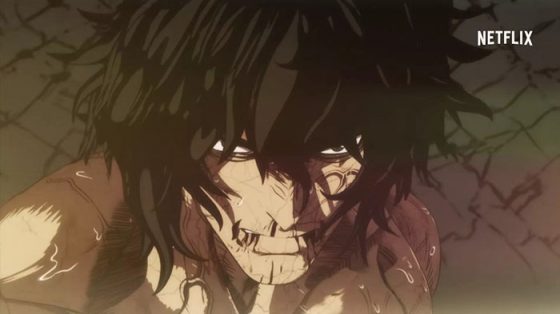With a second season announced for Fall 2019, we thought it’d be great to give you readers a refresher to what Kengan Ashura is all about. Many enjoy it for its high-octane action and we can’t disagree that it does indeed have a load of that. It shows that fighting doesn’t have to be about charging up, power ups, and shooting fireballs. Also, nothing wrong with that, but sometimes, as Bison would say in the live action Street Fighter movie, there’s something about the purity of unarmed combat, and Kengan Ashura manages to capture that. If you’re familiar with the series, the fights portrayed in Kengan Ashura are sanctioned by Japan’s largest corporations. In order to settle disputes or to buy the other out, a corporation uses a champion of their choosing to represent them. In a way, think of it as a trial by combat but in a corporate setting, and this is the basis to why we wish to explain Kengan Ashura.
Corporate Greed
Beyond the action, you can see this is something of a spoof/satire of corporate greed in the same vein the original Robocop movies were. Instead, Kengan Ashura takes that notion into a modern Japanese setting. However, with the way the Kengan Bouts work, for those that are experts in business practices in lets say the confines of their respective nations (at least in context to the US and its territories), there is no way that the practices of Kengan Ashura would ever work in real life beyond the whole illegal fighting novelty. Yes, we understand it’s fiction and only an anime, where the imagination is allowed to be taken to levels of the unknown, but hear (or better yet, read?) us out on this one.
Take for example, the recent Disney/Fox merger. The reason why it took two years to process is due to passing anti-trust requirements (that Disney was also in a bidding war with Comcast, but if Kengan Ashura were real, I’m sure Disney and Comcast would’ve done a Kengan Bout to settle it). Of course, regardless, there were still concerns of antitrust violations throughout the process and even now. The reason why some people may find the concept of Kengan Ashura ridiculous is because they’re not realistic under antitrust laws unless there are no anti-big business politicians that equate to Pocahontas in Japan, or the world of Kengan Ashura to prevent such mergers and acquisitions from happening under such circumstances.
While antitrust laws do exist in Japan, they’re not as strict as, let’s say, America’s, which is why Japanese corporations are allowed to have a structure known as a Zaibatsu. A Zaibatsu is more or less a semi-legal monopoly and such Japanese companies that exist under such a label are Mitsubishi, Sumitomo, and Yasuda. These corporate structures are highlighted in the series, which is why such acquisitions and mergers are possible in the series, of course the methods are obviously applied differently between the world of anime and manga, and in real life. For all we know, perhaps the corporations do pay some penalties in Kengan Ashura and we just don’t know about it. We’re pretty sure they can easily afford to pay them anyway.
Exploiting the Worker
In addition to corporate greed, we can obviously see how the fighters that fight on behalf of the corporations can represent the common worker. They’re the ones doing all the heavy lifting and putting everything at risk for the company. While they do get rewarded for their contributions, in the end, it’s the executives who reap all the rewards. If in the event a fighter loses or gets severely injured, some of them are cast aside like yesterday’s garbage. While this was more explosively applicable in the US before the labor movements and unions, this is also an unfortunate practice in some other nations, and there have been stories in the media that this still happens in Japan. For example, a worker was fired by a bank for taking paternity leave, even when he had a legal right to take it.
Family
While this quality won’t be further expanded until we get to future episodes, by the end of the first season, it lays the foundation to another theme, and it’s about family. Kazuo comes from a broken home with his wife dumping him 10 years prior to the start of the series, and his two sons want nothing to do with him as one son is a hikikomori (or a shut-in), and another son is involved with gang activity. With Ouma, he grew up as an orphan and was raised by his martial arts master until he lost his life in combat. When Kazuo and Ouma spend more time together, Kazuo’s paternal instincts towards Ouma start to develop. While Ouma rejects the notion, he knows that deep down inside, he cares for Kazuo the same way. Kazuo and Ouma have both lost family in their pasts, and through their unusual relationship, they re-gain something that they’ve previously lost.
Final Thoughts

Kengan Ashura is not only full of crazy bouts, but a Motley Crue of wacky characters that further amplify the corporate satire that this series represents. While Kazuo’s company is merely a dummy corporation to represent Ouma as a proxy for his main employer, the series has spoofs and parodies of real life corporations such as Nintendo, McDonald’s, MosBurger, and Panasonic. They’re portrayed in a way that we don’t want to wish to spoil, but all we can promise is that it does fulfill its role in how the series is a satire of corporatism, which is a large percentage of the what series is all about.
Recommended Post
Here’s Why You Need to Watch Kengan Ashura
Recommended Post
Feel the Violence! Kengan Ashura Honey's Highlights Now Out!
Recommended Post





